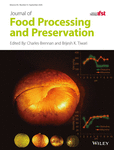Determination of the most potent precursors of advanced glycation end products in some high-sugar containing traditional foods using high-performance liquid chromatography
Abstract
The aim of this research was to investigate the levels of the most potent precursors of advanced glycation end products (AGEs) in some high-sugar containing Turkish traditional foods and investigated the effects of sugar content on the formation of AGE precursors. The amounts of glyoxal (GO) and methylglyoxal (MGO) were determined by HPLC using pre-column derivatization. When we evaluated GO and MGO results, GO and MGO values ranged from 99.8 to 223.3, and from 53.2 to 8,773.7 µg/100 g, respectively. GO and MGO may be formed by Maillard reactions as well as caramelization reactions. Products made with red fruits contained low MGO amounts. Thus, traditional foods containing red fruit may prevent the formation of GO and MGO. In general, we concluded that foods containing proanthocyanidins are more effective in reducing the MGO level than foods containing resveratrol. Further studies are needed to support these results.
Practical applications
Fruit-based and heat-treated traditional foods examined in this study contain high amounts of sugar. The precursors of advanced glycation end products, glyoxal (GO), and methylglyoxal (MGO) may be formed by the Maillard reactions as well as the caramelization reaction in the examined samples. Pestil, sausage, and molasses are products that can be stored for a long time. Therefore, longer storage may also contribute to the increasing amount of GO and MGO. Products made from red fruits contain high amounts of anthocyanins, whereas products made with grape contain high amounts of resveratrol. Products made with red fruits contain low amounts of MGO. In general, foods containing proanthocyanidins are more effective in reducing the MGO level than foods containing resveratrol.
CONFLICT OF INTEREST
The authors declare that they have no competing financial interests or personal relationships that could have appeared to influence the work reported in this paper.




